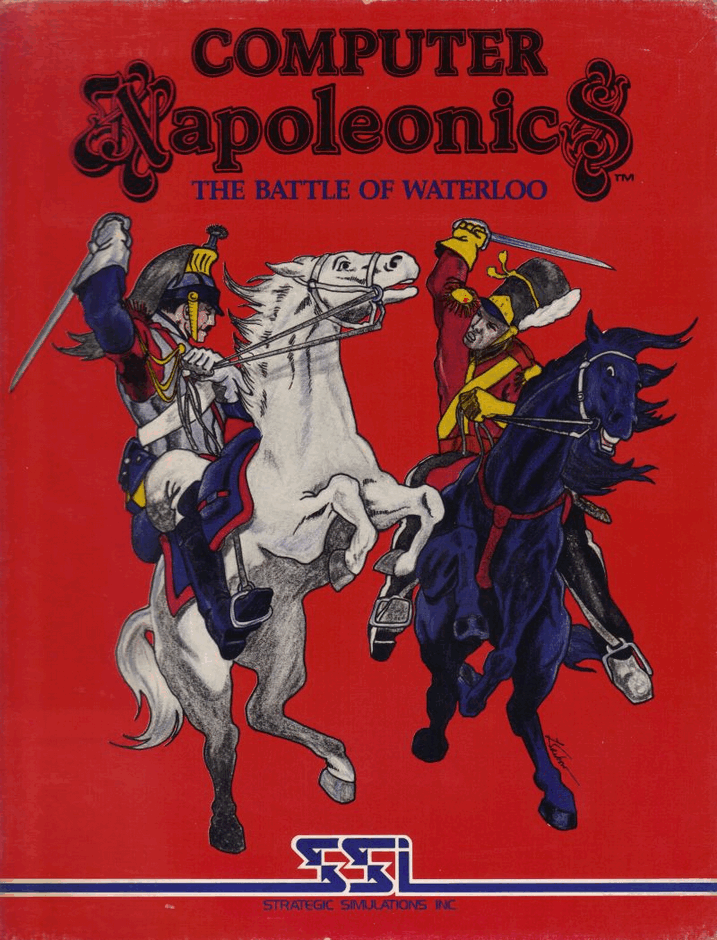
Computer Napoleonics by John Lyon and Joel Billings, published by Strategic Simulations, USA
First release: October 1980 on Apple II,
Tested on Apple II Emulator
Total Hours Tested: 5
AAR: Here
Average duration of a battle: 3 hours
Difficulty: Easy (1/5)
Would recommend to a modern player: No
Would recommend to a designer: No
Final Rating: 28/100
Computer Napoleonics is another “first” of SSI : Computer Bismarck was the first “naval operations” game released for computers, Computer Ambush was the first “squad tactics” game, and now Computer Napoleonics is the first “battlefield strategy” game.
While Computer Napoleonics is the third release by SSI, and already the second one of John Lyon of Computer Bismarck fame, it feels more primitive, more transitional between tabletop games and computer games than its predecessors. In particular, it makes no use of the computer as a neutral third party to implement the fog of war – an element critical in the real Waterloo battle. All other computer wargames released up until then (except for Tanktics) used simultaneous turn resolution (both players prepare their orders, and they are solved at the same time). Computer Napoleonics meanwhile uses a successive turn-by-turn system like tabletop games.
Less innovative and featuring only one battle, Computer Napoleonics is missing from many lists of SSI games, including Wikipedia’s list as I write this entry (a situation I will correct eventually). For this reason, while I could find copies of the game and of the manual quickly, it took me a non-trivial amount of time to find the reference cards, including the all-important unit list and combat result tables – and I was happy to show screenshots of them as part of my After Action Report.
A. Systems
The game has three phases :
- Movement phase: Infantry can move 4 tiles, cavalry and horse artillery 5 tiles, and infantry 3 tiles. Units can go through each other, but units in contact with enemy units cannot move further (including if they started the turn in contact) as they are in the enemy zone of control,
- Combat allocation phase: Every player unit in contact with at least one enemy unit must attack one of those units, and at the end of the allocation every enemy unit in contact with the player must be attacked at least by one unit. This works rather well, the second rule in particular allows units to protect one another and can force the player to do risky “pinning” attacks if they want to focus on one unit in particular.

Note that artillery can attack units one tile away (so range = 2).
- Combat resolution phase: That’s what the game gets wrong. Combat resolution uses a Combat Result Table (CRT): the total strength of the attacker is compared to the one of the defender, and based on this the game throws a 10-faced die on a column with 5 possible results:
- AE : Attacker Eliminated,
- AR : All attackers retreat one tile,
- DR : Defender Retreats one tile, one of the attackers can follow up and occupy the tile left empty,
- DE: Defender Eliminated
- EX: Exchange: The defender is eliminated, the attackers are eliminated for a strength value equivalent to the attacked,
Units that should retreat but cannot (for instance because all the surrounding tiles are within enemy ZOC) are destroyed, so for a Napoleonic simulation, combats are bloody. But beyond that, this CRT is the strangest I have ever seen. The designer considered that the Exchange result is more valuable than Attacker Retreats result, which means that as the ratio is more in favour of the attacker, the number of “EX” results increases – so if you are attacking 5:1 ratio you are more likely to lose your units than if you are attacking at 1:1 or 2:1 ratio !
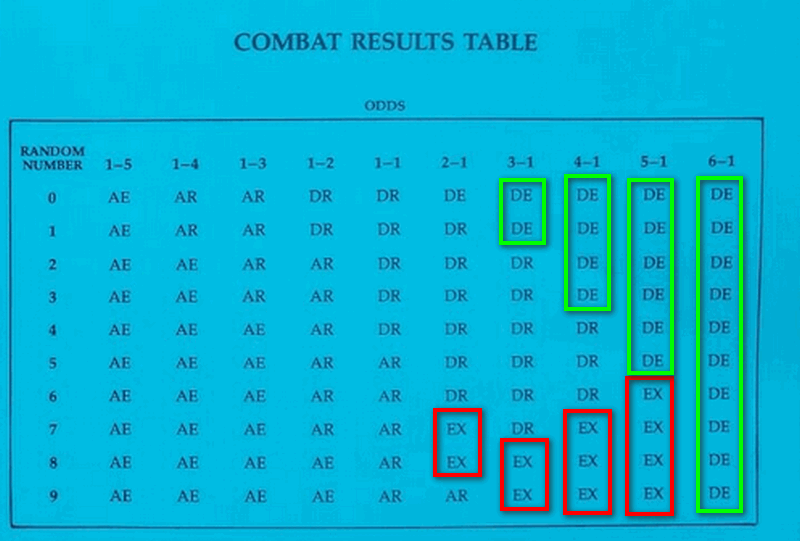
But of course, at least as the French faction, you don’t want to trade your units – you have fewer in total AND you need to leave the board with at least 7 of them.
What you really want to maximize, on the other hand, is the Defender Retreats result, because if you position your units correctly it will immediately destroy your enemy, and even if it does not you can follow your opponent’s retreat with your stronger unit and then your opponent will be forced to attack your stronger at presumably an unfavourable ratio!
The consequence of this combat result table is that as an attacker you will try to target either 3:1 ratio or 6:1 ratio. Even 1:1 ratio (which is what you would achieve in most pinning attack) is riskless, the worst result is attacker retreat (50% chance) and if you have organized properly there will be somewhere to retreat safely.
This is, in my opinion, the most glaring weakness of the game system, which otherwise also lacks depth (infantry and cavalry follow the exact same rules with the only difference being that cavalry moves one tile faster, artillery is just like any other unit except for its range and has no problem fighting in melee, advancing in pursuit or retreating with all its guns,…).
Score : 3/20
B. Settings & Aesthetics
Joel Billings knew his battle of Waterloo and the game shows in the historically accurate list of units that participated in the battle.
Sadly, it is not enough to have the correct names – the ruleset and how the game plays is just as important, and on this Computer Napoleonics fails spectacularly. Most egregiously, as we have seen, units cannot receive damage, just push or destroy their enemies. Due to this, the game feels a lot more like ancient warfare than Napoleonic warfare. It would not even be good ancient warfare, to be honest, due to the prevalence of the “exchange” combat results – where both attackers and defenders are destroyed.
There is no graphics at all, but the first notes of an anthem play at the beginning of each turn: definitely the Marseillaise for the French, something else I could not identify for the Anglo-German-Dutch.
Score : 4/20
C. UI, Clarity of rules and outcomes
In his designer notes John Lyon stated that his objective was to make a game that plays fast (one evening) and is easy to play.
This is a success. While it is keyboard-only, the controls are way simpler than earlier SSI games. The map always displays your last orders, you can change your order at any time and the game will stop you from making illegal moves. After only a couple of turns, I understood perfectly how the game worked, with the exception of the weird rule that blocked Prussian reinforcements turns 4 and 5.
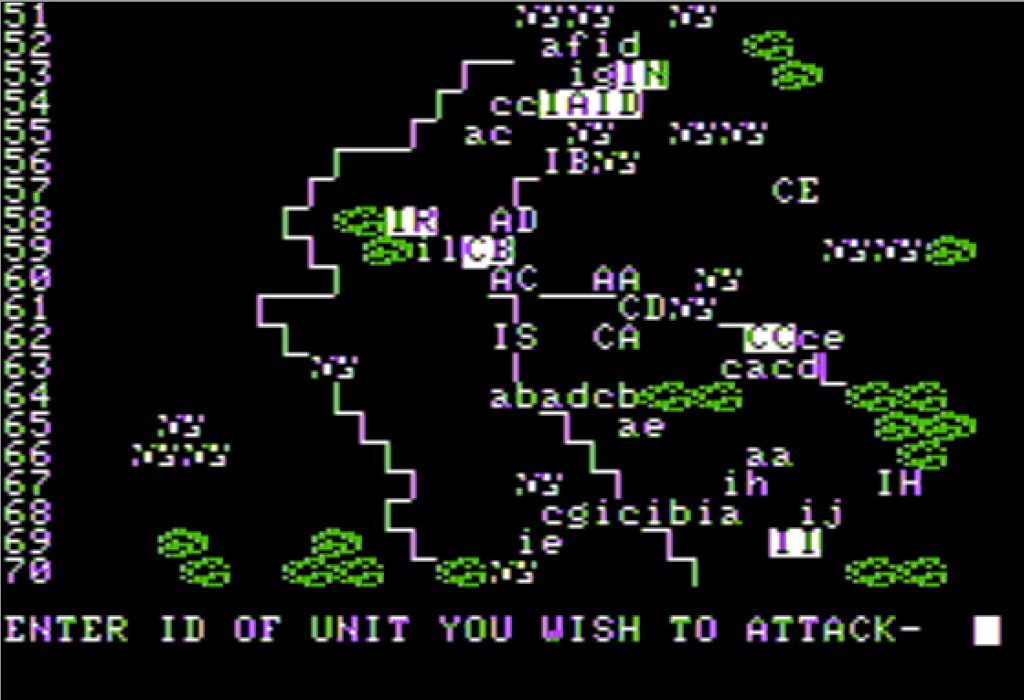
The one frustrating part was the fact that there was no way to know the strength of each unit from the game as it was not displayed anywhere. You must use the reference card. At least, you learn it by practice very quickly and by turn 5 I only had to check it for my artillery.
Score : 12/20
D. Scenario design & Balancing
The scenario is designed well enough to force the player to make some strategic choices (balanced attack or concentrated attack, when to wheel toward the centre, how to deal with the Prussians, …) but it is only one scenario, playable by only one faction.
There is no customization or randomization of any kind, the scenario comes with only two possible variations :
- Whether the Prussians arrive at turn 2 or turn 3
- Whether the French first movement (not the first combat allocation) is done “by the designer” ie a set of hardcoded movements: an all-out assault in the centre, including committing the most elite French unit – the Old Guard – into a frontal unsupported assault against La Haye Sainte. Given the ruleset, those moves are suicidal.
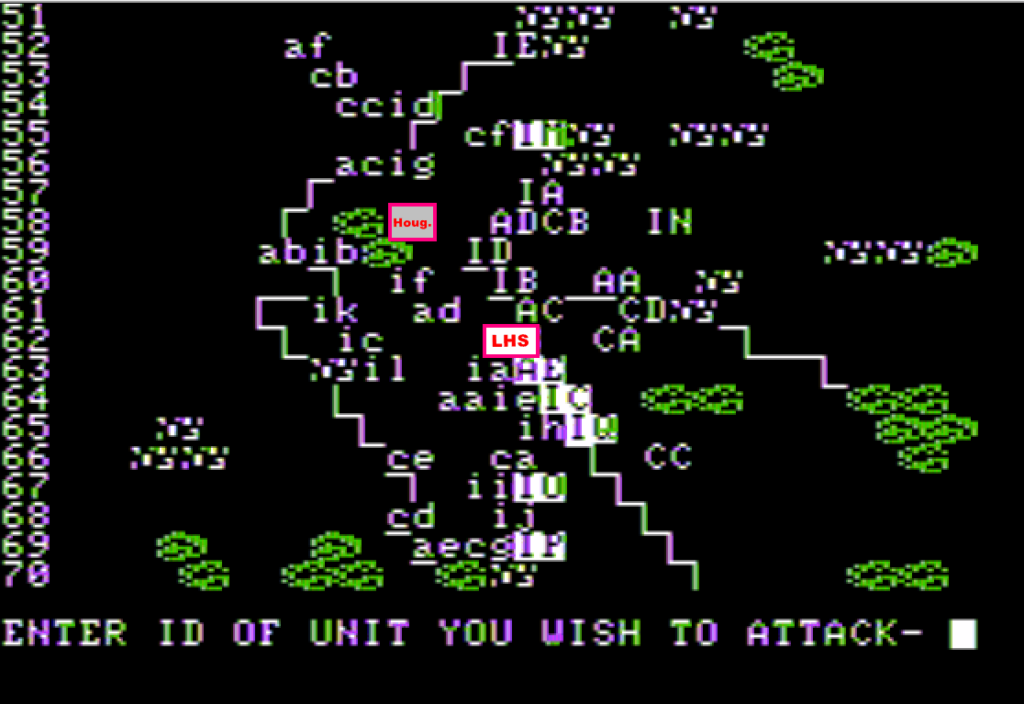
It is hard to say whether the scenario is balanced in multiplayer (I believe it is not, but I would love to find an opponent to verify that). In solitaire, the game is too easy due to the weakness of the AI: it is the first AI I have seen that sometimes keeps trying illegal moves until it finds legal moves to play – it tells anything you need to know about its level.

Score : 4/20
E. Fun & Replayability
Thanks to how easy the game is to pick up, I had some fun in the one complete battle I played. But I have no desire to play again the one scenario the game offers.
Score : 5/20
F. Final rating
28/100. Better than anything Avalon Hill offered, but maybe not worth paying $59 for it.
Contemporary reviews
Computer Napoleonics featured prominently in early SSI marketing materials – one of their taglines was “We can take you from Waterloo to the Super Bowl. (By way of the Atlantic)“. Still, it received few reviews. Michael Humes in Softside (July 1981) found the game very unbalanced in favour of the allies, though like me he also found the AI “fairly easy to beat” following a strategy where “you block the Prussians in the South and allies in the North.” Nonetheless, he found that the game “does not exhaust your interest after a few plays“, though possibly Humes played it in multiplayer mode.
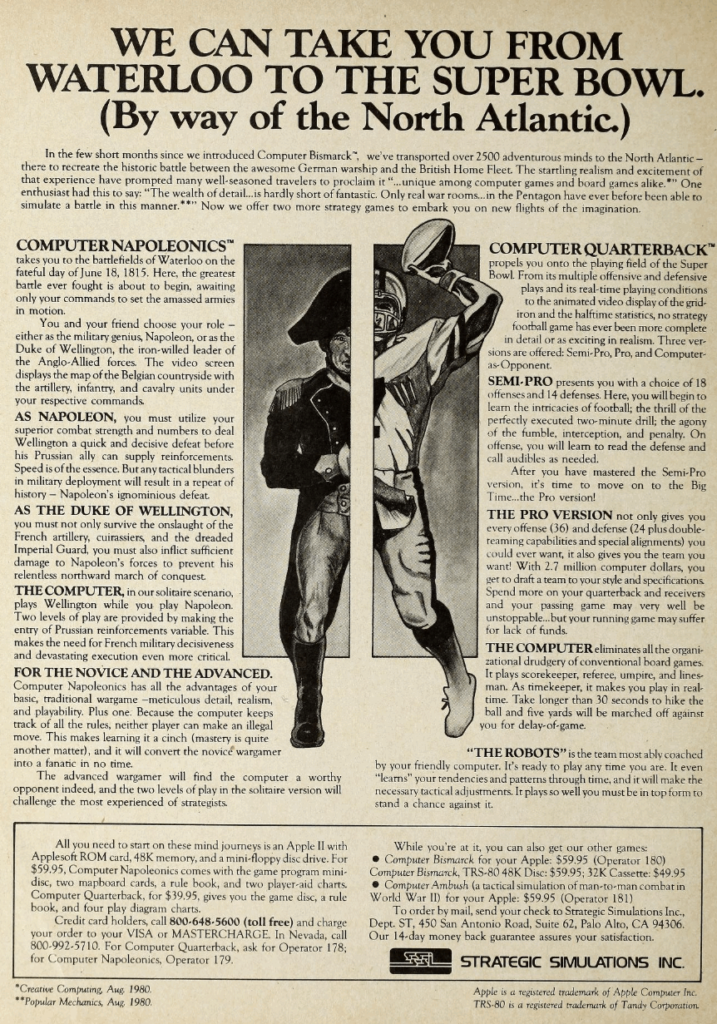
As early as December 1981, John Lyon came back to Napoleon in SSI’s “Napoleon’s Campaigns : 1813 and 1815“. While the scale will be different, it will also include the Battle of Waterloo and will be a more complete game than Computer Napoleonics. This closed the short period during which Computer Napoleonics was alone in its niche – and the game will be quickly forgotten after that.
Computer Napoleonics would gradually disappear from the retailer’s price lists. It is also the first game to be dropped from the SSI catalogue (November 1981 already !) and it would also be ignored by the first retrospective on computer wargames (in the October 1983 edition of the Video Games magazine).
8 Comments
The designer considered that the Exchange result is more valuable than Attacker Retreats result, which means that as the ratio is more in favor of the attacker, the number of “EX” results increases
Not at all. Research which the author was certainly aware of pegged the right ratio at 2:1, based on WWII studies by the US Army. As the number of troops increases, the casualties increase as well without much measurable impact on the victorious outcome. You’ll still win, but take more losses. So what’s the point to attacking with more than 2:1?
I don’t buy it. WWII combat and Napoleonic era combat are obviously very different so the 2:1 ratio you mention (not sure at which scale) would not apply. I suppose the ratio you mention is due to artillery being devastating, and in small scale combat there is only so much cover you can use. But in Computer Napoleonics, there is no artillery defensive fire.
To reach 4:1 or 5:1 ratio, you need to attack from several sides, which means the enemy must spread out his fire, and then has more bayonet/sabers against it in melee.
In addition, there is no reason for an attack supported by artillery to have more chance to give “exchange” results – except if the artillerymen are criminally bad.
Also, in game terms, it is pretty bad design, since you need to make sure to never overwhelm your opponent too much.
I don’t buy it. WWII combat and Napoleonic era combat are obviously very different so the 2:1 ratio you mention (not sure at which scale) would not apply.
This is the designer applying the latest research to his design. In this era of wargames, the simulationist approach was prized above all, and “look at my new design, it incorporates that article that was making the rounds a few months ago.” The research said that attacking at above 2:1 didn’t influence victory, which was all but certain, all it did was increase casualties.
Also, in game terms, it is pretty bad design, since you need to make sure to never overwhelm your opponent too much.
Just like a real general? What an accurate simulation!
There are people who don’t even call them wargames, they call them “consims” or conflict simulations since wargames sounds like Risk or Stratego.
I’d say the latest research on WW2 exchange rates aren’t exactly applicable to a Napoleonic warfare simulation. The dev might get some street cred for using the latest research, but they made their game poorer by using research that’s irrelevant to their goal (simulating Napoleonic warfare)
Sigh. You aren’t the first to complain about combat results tables. Dupuy, that’s who I was trying to think of. He did the research. His paper is the one you want to read. Now that I think about it, it might have been in a US Army Field Manual, not a paper. Regardless…
http://www.dupuyinstitute.org/blog/category/force-ratios/
Well, in any case thank you for the blog, really great stuff.
Interestingly, it says that for the Civil War (based on data analyzed years after Computer Napoleonics’s release obviously) a 2:1 attack has 50% success rate, and a 3:1 attack has 100% success rate. No mention of the losses on the attacking side, and I am not planning to order Dupuy’s book for the time being.
I am not planning to order Dupuy’s book for the time being.
…and you call yourself a grognard…
Well, you’re moaning about CRTs being unrealistic, so I suppose that’s grognard-ish.
Ah. Found it.
“Dupuy was so certain of the validity of the data on this that he made it an aphorism of his own: In the average modem battle, the attacker’s numerical strength is about double the defender’s.”
Trevor N. Dupuy. Numbers, Predictions and War: Using History to Evaluate Combat Factors and Predict the Outcome of Battles. Indianapolis; New York: The Bobbs-Merrill Co., 1979, p. 13